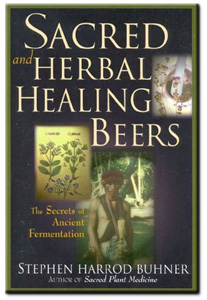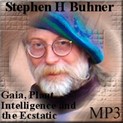Paradise Lost: Of Healing, the Sacred, and Beer
by Stephen Harrod Buhner
Written 1998, Copyright © 2003 Stephen Harrod Buhner
Excerpt from Sacred and Herbal Healing Beers:
The Secrets of Ancient Fermentation
(part two)
It seems odd, when talking about beer, to also speak of healing disease, enhanced sexual drive, divine mystery, and altered states of consciousness for beer is the most mundane of things.  It is, in fact, considered plebeian in our time - wine is elegant, beer for the common, sweaty folk. But that has only been a truth for a short blink in human history. Before that things were different, beer was one of the portals into the deeper mysteries of the universe and it was much more than a relaxing beverage.
It is, in fact, considered plebeian in our time - wine is elegant, beer for the common, sweaty folk. But that has only been a truth for a short blink in human history. Before that things were different, beer was one of the portals into the deeper mysteries of the universe and it was much more than a relaxing beverage.
The ancient beers, discovered independently across the world between 10 and 30,000 years ago, were quite different than what we know as beer today. There were hundreds if not thousands of them using some 20 different kinds of yeast, perhaps 15 different sugar sources, and over 200 different plants. Many were sacred beers, scores were highly inebriating or psychotropic, and hundreds contained medicinal herbs. They were made for sacred ceremony, for attaining nonordinary states of reality, for communicating with the ancestors, as potent nutrient foods, and for healing.
Such beers were the expression of an entirely different way of seeing the world. They came out of a world view in which the sacred is ever present with us, where all things possess a soul, the rocks are alive, and in which rabid destruction of the rainforest is inconceivable. The ancient beers come from cultures that, on every continent on Earth, say human beings did not discover fermentation at all. They say it was given to human kind through the intercession of sacred beings and they insist that these ancient beers contain within themselves some of the essence of the sacred source from which they come.
The Tarahumara Indians, when making pulque, a fermented agave cactus beer, place the sweet water-and-sap mixture in special clay jars. They call fermentation "boiling" and once a jar "learns to boil" it is placed near other jars (filled with unfermented pulque) that have not learned how to boil so that they might be taught to do so. The tribal highlanders of New Guinea say that the rainforest wildlife is not only good to eat but also "good to think." And Native holy people throughout the Americas insist that if a person treats the spirits of plants like they treat other human beings then the plants will talk and teach their use as medicines. This kind of perspective, a perspective embracing the living intelligence of the Universe, the understanding that all matter possesses a soul essence, is pervasive in the deeper world of fermentation.
The oldest legends, in every culture on Earth (and it is a lie that indigenous people did not know alcohol - human beings on every continent except Australia have fermented for at least 30,000 years), all reveal that fermentation was a seminal event for human beings. They all claim that fermentation came from a sacred source, it was given to human beings to help them with the human condition, and that when the human and the spirit of a fermented plant first met the result was the origin of poetry. One of the oldest of these is the Norse saga the Edda, which tells of the sacred origin of the Mead of Inspiration. (Mead is fermented honey and water.) And in another, the ancient poem, the Runahal, it is said that:
A drink I took of the magic mead,
Taken out of Othrorir.
Then I began to know and to be wise,
To grow and to weave poems.
This recognition of the intimate connection between poetry and fermentation is truly ancient and pervasive. Ralph Waldo Emerson, commenting on this, notes that:
[The poet speaks] not with intellect alone but with the
intellect inebriated by nectar. As the traveller who
has lost his way throws the reins on his horse's neck
and trusts to the instinct of the animal to find his
road, so must we do with the divine animal who carries
us through the world. For if in any manner we can
stimulate this instinct, new passages are opened into
nature. . . . This is the reason why bards love wine,
mead, narcotics, coffee, tea, opium, the fumes of
sandalwood and tobacco, or whatever other procurers of
animal exhilaration.
The earliest fermentations took place with "easy" sugars: tree saps (such as maple and palm), fruits (grapes and elderberry), and honey. All of them were considered sacred. In some of the legends of African peoples, it is the elephant that brought the knowledge of fermentation from the sacred to human beings. And it is true that elephants also make beer. They knock down palm trees, step on the trunk to make a depression, and the hole fills with the sweet sap. Then they wait, slowly rocking themselves as the yeasts come to the sweet sap, quickly fermenting it in the tropical heat. Like us, the elephants experience activation of portions of their brain that are uniquely energized by alcohol.
In other parts of the world it was the bee that brought human beings the knowledge of fermentation from God. In the Mithraic religion the bee is pictured in the mouth of the lion - it is the WORD that comes from God. And in the Chaldee language the WORD is the same as the word for bee.
The knowledge of grain fermentation came to us 11,000 years ago - some 19,000 years later than the others. We have been drinking since before we could think - we have been thinking since we started drinking. There is now growing evidence that all civilization rests on the discovery of fermentation.
Most beers and ales that we now recognize as "beer" come from fermented grains. Unlike honey, these sugars are protected from yeasts - they have been converted to starch. As a result it is not so easy to make a beer from grain - a few other steps are necessary. It takes more work, more technology.
For a long time archaeologists and scholars have insisted that the domestication of grain was the beginning of civilization. They have insisted that increasing population caused settlement along the Nile River delta and subsequently the domestication of grain to feed the growing masses. But there is evidence that agriculture began even earlier and that maybe, just maybe, fermentation came before grain domestication - a possibility that outrages many.
Researchers Solomon Katz and Fritz Maytag, among others, have proposed that it was the discovery of grain malting and its subsequent fermentation that was the original motivation of societies to settle and grow grain. Verification that this might be true can be found among the Chagga of Tanazania's Mount Kilimanjaro. Their extensive irrigation systems were developed in antiquity solely to provide sufficient water to grow millet, which is rarely eaten, being a beer crop. And among the Lepcha of the Himalayas millet, a primary crop, is so sacred that it is never eaten and is used only for fermentation.
This kind of sacred reverence and religious devotion was particularly true of barley in Egypt and, eventually, grain in Greece.
In the ancient Egyptian temple of Philae, Osiris is engraved on a sarcophagus - ears of wheat rising from his body. Below this an inscription reads: "This is the form of the unmentionable, secret Osiris who is speeding upwards." And in ancient Athens, initiates in the Elusian Mysteries were shown, at one point, "the mighty and marvelous and most complete epoptic mystery, an ear of grain reaped in solemn silence." Initiates in the Mysteries participated in highly complex ceremonies that were originally held every five years. At the end of many days of ceremony and ritual they engaged in the supreme act of the Mysteries: opening the kiste, working with its contents, and then drinking kykeon. The chest, Kiste, held the tools needed to turn grain into kykeon, the sacred drink made from barley. By taking the grain into their bodies, as food and fermentation, human beings brought into themselves the body of the sacred itself.
This extensive use of grain fermentation and plants in fermented beverages moved slowly into Europe and a unique form of sacred and herbal healing beers reached its zenith in the Middle Ages in Europe. Fermentation is intimately connected to traveling in sacred realms. The alcohol produces its own consciousness altering effects, the plants used in fermentation are sacred and that sacredness changes those who ingest them, but in many cultures, for a variety of reasons, additional plants were also added during fermentation. Some of these were for medicinal or culinary reasons but there are ancient traditions of sacred plants that, in themselves, significantly alter human consciousness.
by Stephen Harrod Buhner
author of Sacred and Herbal Healing Beers
read (part two)
Sacred and Herbal Healing Beers:
The Secrets of Ancient Fermentation

Paperback by Stephen Harrod Buhner. 450 pp. Herbal healing beers of the world.
This is the first comprehensive book ever written on the sacred aspects of indigenous, historical psychotropic and herbal healing beers of the world.
"Filled with nourishment for the soul, body, and mind, this book is a unique view of the intersection between herbal medicine and fermentation. It will delight anyone interested in herbs, honey, brewing and folktales. Great Book!" -- Susun S. Weed, Author of Healing Wise.
Price: $19.95
Order Sacred and Herbal Healing Beers in our Bookshop
Healing Lyme: Natural Healing and Prevention of Lyme Borreliosis and Its Coinfections
 Paperback by Stephen Harrod Buhner. 288 pp. The essential guide to Lyme infection and its treatment.
Paperback by Stephen Harrod Buhner. 288 pp. The essential guide to Lyme infection and its treatment.
Healing Lyme examines the leading, scientific research on Lyme infection, its tests and treatments, and outlines the most potent herbal medicines and supplements that offer help—either alone or in combination with antibiotics—for preventing and healing the disease.
It is the essential guide to Lyme infection and its treatment.
A must have book for anyone dealing with Lymes...
Price: $19.95
Order Healing Lyme in our Bookshop
also on CD....
Healing Lyme - 2 CD set
Stephen H Buhner. 8th International Herb Symposium 2007.
 In this workshop Stephen presents the research and treatment interventions from his book "Healing Lyme: Natural Healing and Prevention of Lyme Borreliosis and its Coinfections."
In this workshop Stephen presents the research and treatment interventions from his book "Healing Lyme: Natural Healing and Prevention of Lyme Borreliosis and its Coinfections."
The ecology of the Lyme bacterium, how and why it affects the organ systems it does, and multiple, coordinated intervention approaches will be discussed. Updates from the more than 400 people who have used the protocol will be presented.
Price: $22.50
Order Healing Lyme - 2 CD set in our Bookshop
digital downloads by
Stephen H. Buhner

Gaia, Plant Intelligence and the Ecstatic
- digital download
Stephen H. Buhner. 8th International Herb Symposium 2007.
Teacher: Stephen Harrod Buhner
Price:$19.95

The End of Antibiotics - digital download
Stephen H. Buhner. 5th International Herb Symposium 2000.
Teacher: Stephen Harrod Buhner
Price:$19.95

Sacred Plant Medicine - digital download
Stephen H. Buhner. HerbFest 1999.
Teacher: Stephen Harrod Buhner
Price:$19.95



 Paperback by Stephen Harrod Buhner. 288 pp. The essential guide to Lyme infection and its treatment.
Paperback by Stephen Harrod Buhner. 288 pp. The essential guide to Lyme infection and its treatment.





